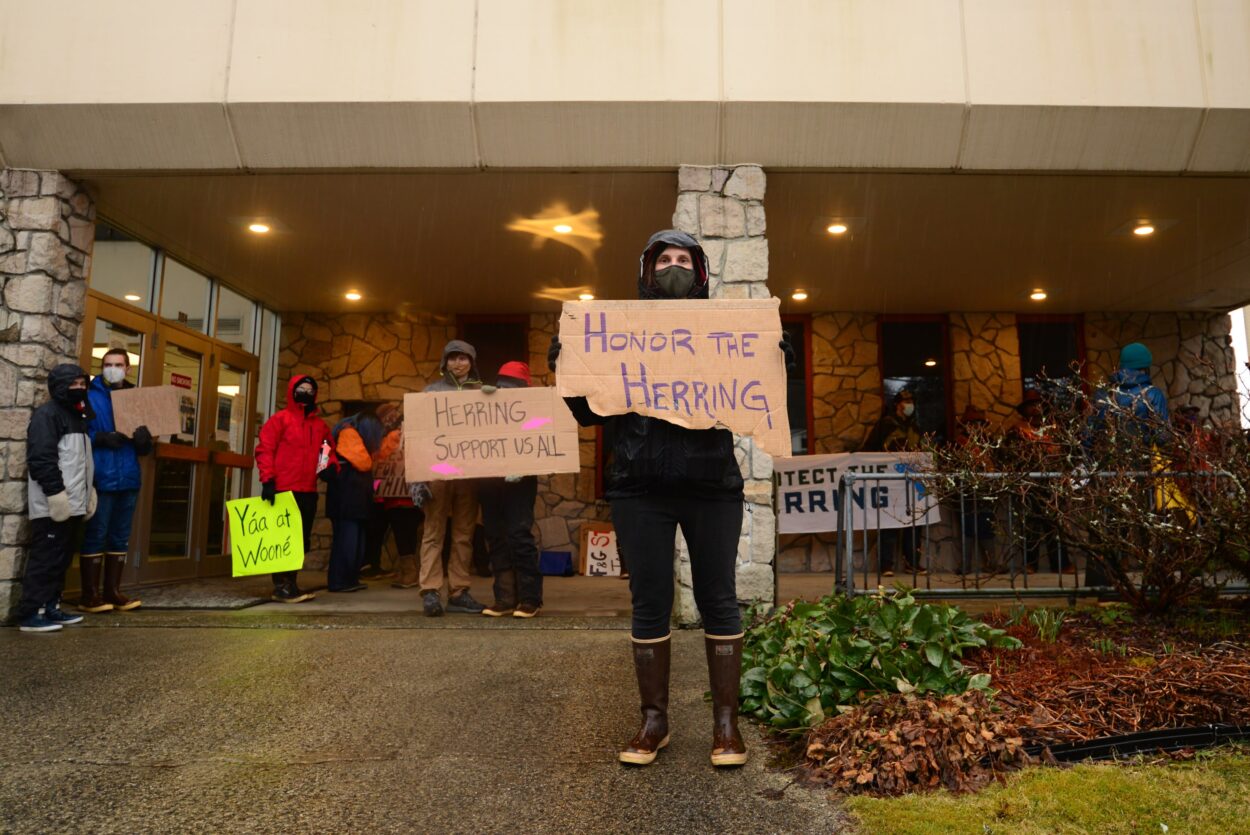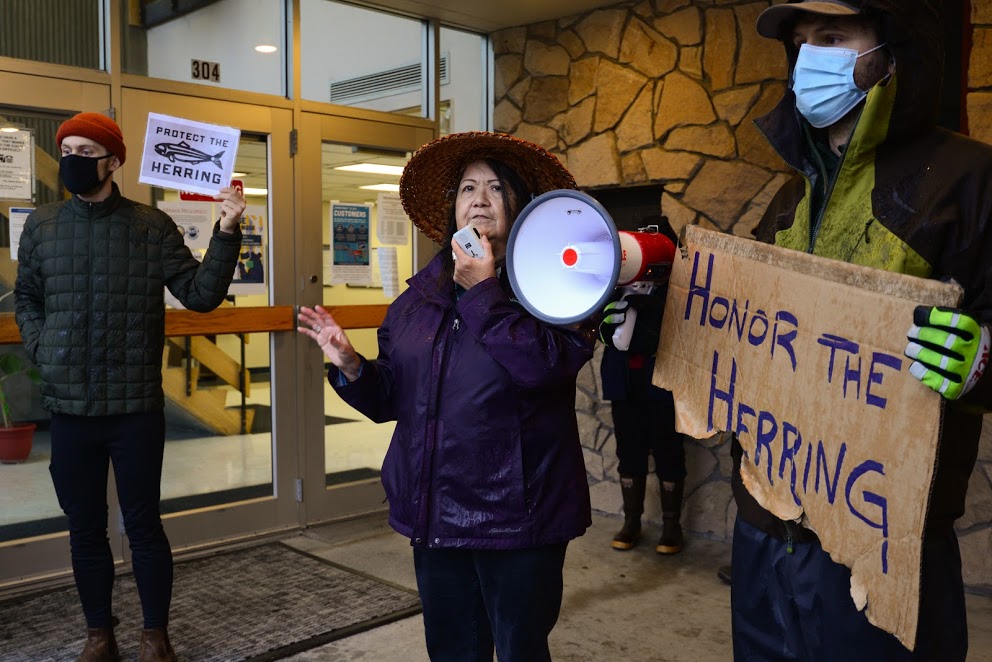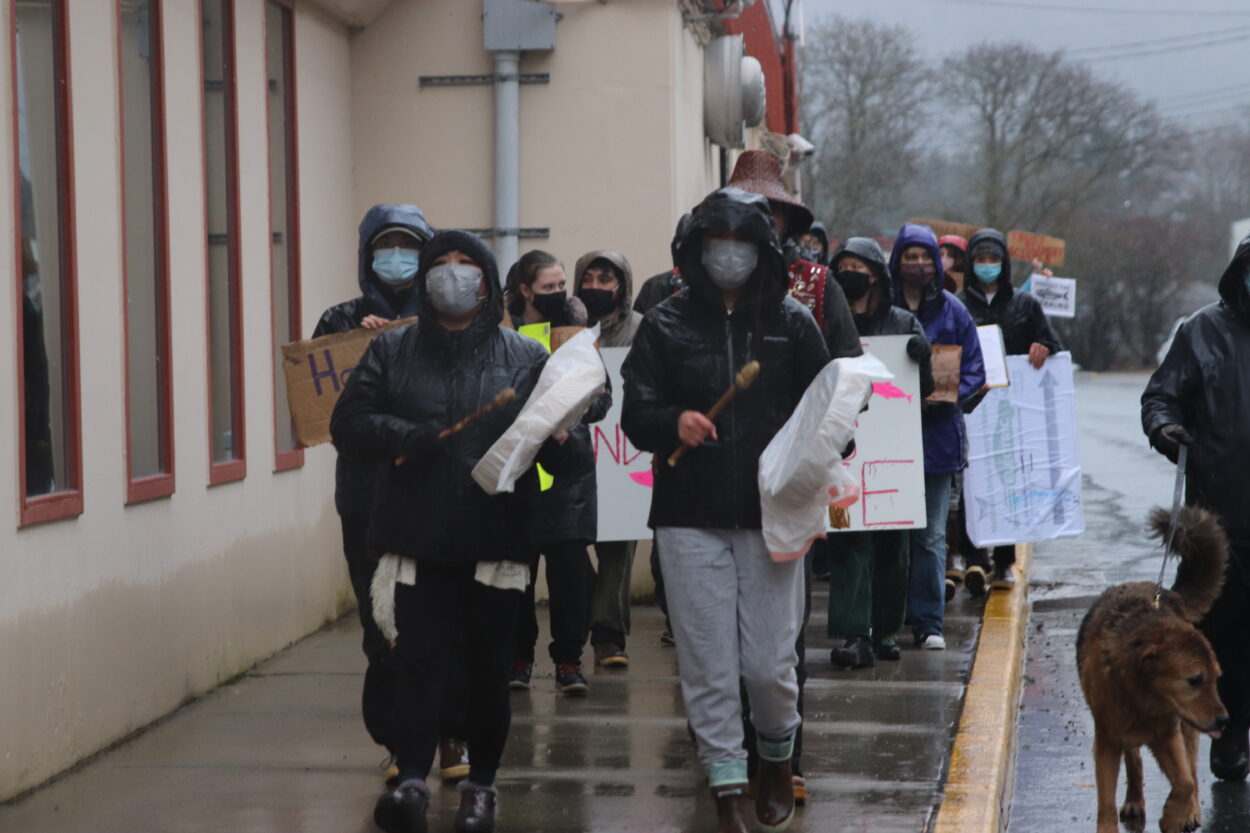
Herring season is underway in Sitka, and a commercial fishery is likely to happen, after a two-year hiatus. Earlier this week (3-15-21), demonstrators gathered outside Sitka’s courthouse, to catch the attention of the Alaska Department of Fish and Game, calling for changes to management of the fishery.
A group of around 60 demonstrators are marching around the Sitka Courthouse in the pouring rain. Some participants drum and sing while others hold signs that read things like “honor the herring” and “33,000 tons? You’ve got to be crazy.”
The demonstration was organized by a local activist group called the Herring Protectors. The group advocates for herring and subsistence harvesters, and calls into question the state’s management of the commercial herring fishery. They’ve chosen to demonstrate here because the Alaska Department of Fish and Game office is inside the courthouse, and they want to catch the department’s attention, as the commercial herring season approaches
Standing in front of the courthouse doors, Louise Brady picks up the megaphone to speak to the crowd.
“I really appreciate you being out here because the voices of our Tribal Elders, the voices of our culture bearers have spoken loud for several decades at the Board of Fish with no response,” she says. “With no response. Because our herring are so precious to us.”

Brady points out a sign that says “Respect Tlingit science.” She says Tlingit people took care of the land and waters for thousands of years, successfully. And Elders have been testifying before the state’s Board of Fisheries for decades now, concerned about changes to the herring spawn and a species in decline.
“They have been trying to tell the state that without herring, we all are going to be in trouble because the herring, the spirit of the herring, they feed us every spring,” she says. “They feed the salmon, they feed the birds, they feed the whales. They feed us.”
The commercial fishery didn’t open last year or the year before. The fish were too young and small to be marketable abroad. But this year, a fishery is looking more likely. Based on their models, state managers believe it’s sustainable to open the fishery this year, with the highest forecast of fish since the state started recording data in the 1970s. The Department of Fish and Game met on March 12 to review data from the past two years, and talk about projections for 2021. Sherri Dressel is a state fisheries biologist.
“We expect to see a high number of 5-year-olds and the forecasted average weight has now gotten up to 112 grams. And that’s for all the fish in the population,” she says.
ADF&G is predicting around 210,000 tons of herring will return to Sitka Sound this year. Of those fish, it has set a harvest limit of 33,000 tons. So far this spring, state aerial surveyors haven’t observed herring spawn in Sitka Sound. Spawning could begin any time between now and April.
But subsistence harvesters continue to report harvesting challenges, and Sitka isn’t the only place where access to the traditional food has become more difficult. ANS Grand President Paulette Moreno noted a court order filed in Canada earlier this month. The Gwa’sala-‘Nakwaxda’xw Nations, a First Nations government in British Columbia, filed an injunction on March 9 to stop a commercial herring fishery near Vancouver because they found stocks were too low to sustain a harvest. Canadian officials have agreed to delay the fishery until a judgement is reached.
“And their Board of Fish People are standing aside, and they may allow the herring to come forward. But until their injunction is heard, they are standing aside because the Native people of that land have spoken,” says Moreno. “We are asking for that same respect.”
Sitka Tribe of Alaska sued the state over management of the commercial fishery in 2018. The case is still being litigated, but the Tribe has already won some ground in the fight. Last year, a Juneau judge ruled that the state had not demonstrated that it allowed for ‘reasonable opportunity for subsistence” in the management of the fishery, and ordered the department to make some changes.
According to an STA press release, the Tribe is working with the state to conduct in-season subsistence harvest monitoring this year– a result of the court’s ruling. The daily data they collect will be considered by ADF&G biologists throughout the commercial fishery, to ensure subsistence harvesters have “reasonable” access to the resource.
The commercial fishery goes on ‘two hour notice’ on March 20th. And the Herring Protectors say they will continue to organize in the coming weeks.
































